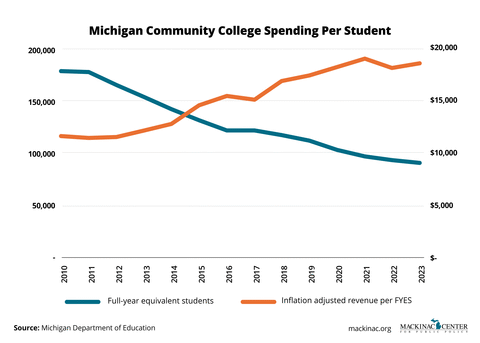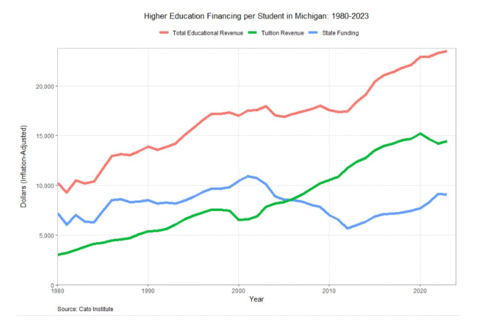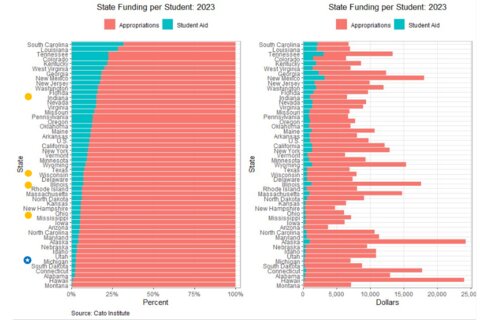Michigan higher education policy is out of wack — here’s how to improve it
Give the money directly to students, not the universities
Michigan taxpayers are spending $2.7 billion supporting their 15 public universities and 30-plus community colleges. What are they getting for their money?
It is hard to say. The number of four-year college students is down 20% over the past decade. Graduation rates are improving, but only about half of students at public universities finish in four years.
For community colleges, the results are worse. Just a quarter of community college students complete a degree in two years. Half don’t finish after six years, and likely never will. Michigan had 481,000 students in community college in 2010, a number that has plummeted to 280,000 in the most recent accounting. State funding per student is up significantly, but results are lacking.
One thing that has not gotten worse? Revenue for the colleges. It’s up enormously over the past decade and is currently at the highest level ever.
Michigan's higher education policy does not seem well thought out. Lawmakers are not appropriating money based on anything important, such as the number of students served, graduation rates, financial value, or meaningful performance metrics.
The biggest problem? Michigan doles out most of its money by appropriations. It gives direct funding to universities themselves, rather than to students in the form of financial aid. Moreover, research shows that appropriations have little or no effect on tuition. So taxpayers spend significant sums without keeping tuition modest.
Other states do things differently than Michigan. They set up performance metrics, which means colleges get more money if they do a better job holding down tuition, increasing graduation rates and placing students in jobs.
These states also distribute higher education money as financial aid, not direct appropriations. Giving grants directly to students rather than colleges lets states give money to populations of need. It also reduces political infighting between universities, empowers the student rather than the college and improves competition among institutions.
Across the 50 states, Michigan is near the bottom when it comes to giving money directly to students as financial aid. Nearly all of our university spending goes out as appropriations, empowering colleges rather than students.
In recent years, taxpayers have paid more to send fewer students to college, and completion rates remain abysmal. For the first time in decades, tuition rates are coming down, probably driven by fewer students attending college. Lawmakers can help that trend by taking the money directly appropriated to the universities — with little accountability — and giving it directly to Michigan students to use at the college entity of their choice.
Jarrett Skorup is vice president for marketing and communications at the Mackinac Center for Public Policy, a free-market research and educational institute in Michigan. Dr. Andrew Gillen is a senior research fellow in higher education at the Cato Institute.
Michigan Capitol Confidential is the news source produced by the Mackinac Center for Public Policy. Michigan Capitol Confidential reports with a free-market news perspective.






 Michigan manages to lose students while hiking higher ed spending
Michigan manages to lose students while hiking higher ed spending
 Report lays out costs of banning short-term rentals,
Report lays out costs of banning short-term rentals,
 There is no such thing as ‘the state’s dime’
There is no such thing as ‘the state’s dime’

 Clean fuel proposal would drive up gas prices 34 cents per gallon by 2035
Clean fuel proposal would drive up gas prices 34 cents per gallon by 2035
 Walberg bill would roll back anti-gas engine regulations
Walberg bill would roll back anti-gas engine regulations
 Bills would redirect corporate welfare to pave roads
Bills would redirect corporate welfare to pave roads